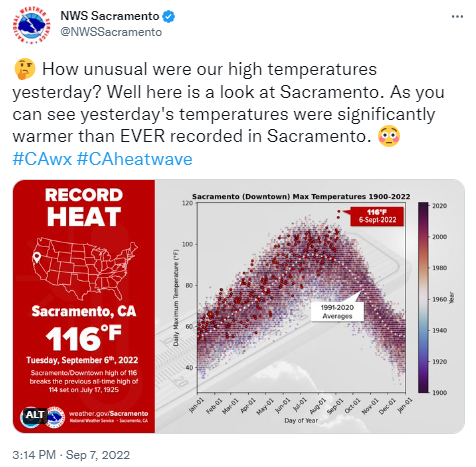Keeping the Lights on in California, and What it Means for New York

While we’re in the depths of winter, it’s easy to forget about how extreme heat can impact the reliability of the electric grid. But it wasn’t too long ago (back in early September 2022, to be exact) that much of the nation west of the Rockies experienced a record-breaking heatwave, notable for its intensity and duration.

in Sacramento, California on September 22, 2022.
Of the states impacted, California saw the most extreme temperatures. Sacramento and San Jose reached 116- and 109-degrees Fahrenheit, clinching all-time records, according to weather historians.
Temperatures and extreme weather like the kind experienced in California last year can stretch any power grid to its limits. California’s grid operator, the California Independent System Operator (CAISO) recorded record consumer peak demand during the heat wave, issuing several of what it called “Flex Alerts,” urging consumers to set their thermostats to 78-degrees Fahrenheit or higher, avoid using major appliances, and turn off unnecessary lights.
In addition, the CAISO requested the activation of four new, natural-gas generators to provide up to 120 megawatts (MW) to the grid, according to the California Department of Water Resources.
CAISO said the decision to dispatch the fossil-fuel generators was necessary to avoid blackouts.
New York’s Grid Planning Safeguards Are Unique
The New York ISO conducts a variety of studies that help determine if reliability could be at risk in the future. Our Reliability Needs Assessments and Comprehensive Reliability Plans regularly assess the state of change on the grid and determine what new electric resources and transmission upgrades may be needed to maintain reliability in the future. This, in turn, helps us determine the steps to prepare for future grid demand and to communicate those needs to policymakers, developers, and stakeholders. We also perform quarterly Short-Term Assessments of Reliability (STAR) that look ahead five years to identify risks to reliability.
We’ve recently released the 2021-2040 System & Resource Outlook that looks ahead 20 years to see what transmission and resource investments will be needed as we move to a zero-emissions grid.
State policy, like the state’s CLCPA, mandates that we work toward an emission-free electric system by 2040. As the grid operator in New York, our mission is to operate a reliable electric grid, even as it transitions to new clean energy technologies. A carefully planned transition from the power system of today to the clean-energy grid envisioned by the CLCPA is essential to avoid the risks to reliability experienced in the western United States last summer. Large-scale, emissions-free technologies that can be dispatched quickly and operate throughout peak-demand periods must be available to replace the peaking technologies that have served and continue to serve the grid.
Today, these technologies are not commercially available at scale. In the meantime, as New York moves toward a clean-energy future, fossil-fuel resources will continue to play a valued role in ensuring grid reliability.
Also in September, CAISO approved extending what are known as “Reliability Must Run” (RMR) contracts through 2023 with four fossil-fuel power plants. RMR contracts require power plants to continue operating to meet capacity needs in return for specified compensation. CAISO originally approved RMRs for these units in 2019 due to concerns with projected capacity shortfalls. The extended agreements address capacity concerns through the entirety of 2023.
East and West Coast Similarities
In September, the state of California enacted a sweeping plan to achieve a zero-emissions grid by 2045. In New York, the Climate Leadership and Community Protection Act (CLCPA) requires transitioning the electric grid to renewable and zero-emissions resources by 2040.
Like California, New York’s grid also greatly relies on fossil fuel plants. Some of these generators, operate infrequently but are essential for reliability on high demand “peak” days. Known as “peaker” plants, these units can be important for maintaining reliability and avoiding the kind of situations like California experienced this past summer.
The question facing us is how to transition from fossil fueled plants like peakers to a system supplied primarily by intermittent, renewable resources while avoiding the reliability risks that led to the measures taken in California.
Recent New York regulations require many of these peaker plants to comply with stricter emissions requirements by the end of 2023 and 2025. Some units are planning to deactivate. Others may make investments to improve the unit’s emissions profile.
The challenge, as much of this generating capacity retires, will be to bring on-line new, cleaner generation capacity with the operating attributes needed to maintain grid reliability, even on the most stressful, high demand days of the summer. If we experience an imbalance between retirements and new generation coming onto the grid, the NYISO, like California, may be required, to ask generation to remain operational.
Learn More
How did New York's grid stay reliable in a deep freeze during the December 2022 holiday-week winter storm? Read more.
